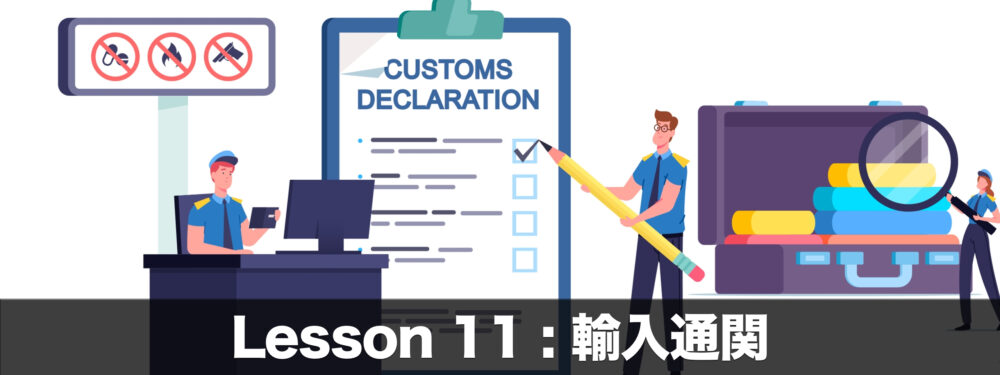
Overview


There are things like customs duties to pay, too.


The key is to prepare in advance.
What You Learn in This Topic
- Customs Procedures in Maritime Import
Import Customs Clearance Procedure
Customs clearance for maritime imports proceeded as follows.
2. Cargo is brought into the bonded area
3. Confirmation of Shipping Documents
4. Request import procedures to customs brokers
5. Request internal transportation to the Carrier
6. Arrangements for Marine Insurance
7. Paying expenses and preparing for delivery
8. Import Declaration
9. Payments of customs duties and consumption taxes
10. Document examination (cargo inspection, if any)
11. Once the import permit is granted, the goods are carried out from the bonded area

1. Receive S/A from Exporter

Once the cargo departs from the origin, the importer receives the Shipping Advice (S/A) from the exporter. S/A includes the following documents:
- Bill of Lading (B/L)
- Invoice
- Packing List
- Permits or certificates required by regulations
- Catalog or Material Safety Data Sheet (MSDS)
- Certificate of Origin, etc.,

Additionally, a few days before the vessel arrives at the port, the consignee will receive an Arrival Notice (A/N) from the shipping company.
Arrival Notice(A/N)
An Arrival Notice serves as an alert or notification that the cargo is about to arrive. It typically includes details such as:
- Estimated arrival date of the vessel
- Port of arrival
- Container or shipment details
- Instructions for the consignee to make necessary arrangements for customs clearance and cargo pickup
The Arrival Notice (A/N) is sent to the contact information listed in the Notify Party section, often the forwarders or customs brokers. If the importer receives the A/N, they should promptly forward it to the customs broker via email or fax.


2. Cargo is Brought into the Bonded Area
The cargo that has arrived at the port is brought into the bonded area. The bonded area is where foreign goods are temporarily stored before being cleared through customs.
The cargo will be stored in the bonded area until the necessary permits are issued.

3. Confirmation of Shipment Documents
The importer checks for any deficiencies or errors in the S/A documents. In case of discrepancies or shortages, the importer must promptly report to the exporter to obtain replacement documents.

4. Request Import Procedures to Customs Brokers

The importer requests a customs broker for the customs clearance procedures. Then, they verify whether the imported goods fall under the categories outlined in the destination country’s customs regulations and other applicable laws.
Verifying if the goods fall under designated categories in regulations before importing is recommended. If applicable, the consignee has to prepare the necessary documents in advance to get permission.

5. Request Internal Transportation to the Carrier
The importer chooses a transportation provider and requests domestic transportation arrangements. In some cases, the customs broker may handle the transportation arrangements on behalf of the importer.
6. Arrangements for Marine Insurance
This is the case where the importer is responsible for arranging the insurance.
Insurance should typically be arranged before vessel loading. But if there are delays in receiving vessel information, it should be completed at least before arrival.

7. Paying Expenses and Preparing for Delivery
The customs broker pays the shipping company expenses on behalf of the importer. The costs are listed in the A/N, and the contents are like:
・Ocean Freight
・Terminal Handling Charge
・CFS Charge
・D/O FEE
・DOC Fee, etc.


Once the customs broker pays the fees and hands the endorsed B/L to the shipping company, they can obtain the Delivery Order. Then, the customs broker will prepare for the pickup of the cargo.
Delivery Order (D/O)
Delivery Order (D/O) is a document issued by the shipping company that instructs the operator in the bonded area to release cargo. The consignee can pick up the cargo by submitting the D/O to the operator.

8. Import Declaration

Upon confirming the transportation of the cargo to the bonded area, the customs broker will proceed to submit the import declaration on behalf of the importer.
It must be declared to the customs office with jurisdiction over the bonded area where the goods are stored.


9. Payments of Customs Duties and Consumption Taxes
10. Document Examination (Cargo Inspection, if any)
Customs will review the shipping documents that the customs broker has submitted. If customs deems it necessary, a cargo inspection may be performed.

(1) Import approval is granted immediately after the declaration
(2) Document examination is performed (submission of shipping documents required)
(3) Cargo’s physical Inspection is performed

11. Cargo Release


Take the Test
Reinforce your understanding of this topic by working through the exercises. Attempting the exercises without referring to the material as much as possible is advisable.




